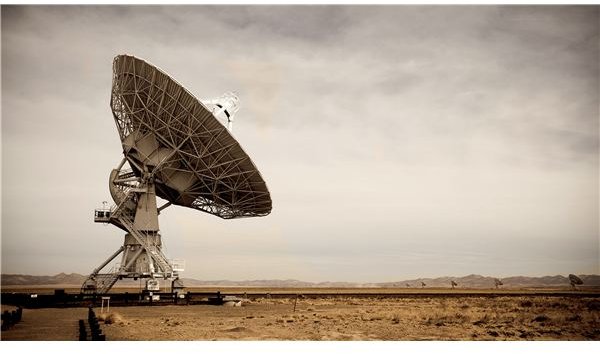The Very Large Array (VLA) of New Mexico and The Future of the EVLA
On to Science…
The Very Large Array (VLA) is different than what one may be used to when it comes to ground based astronomy. We often think of Radio or Optical telescopes as being fixed in place, and as having only the ability to change which part of the sky they are aiming toward. The VLA is much more flexible than the traditional radio telescopes. See, the twenty seven radio telescopes are positioned on railroad tracks, forming a huge Y.
These tracks, each of which is 13 miles long, give this radio telescope the ability to change positions. This allows the VLA to select a specific angular resolution based on the needs of the projects being pursued. A very unique and useful feature for a radio telescope, for sure. This gives the 27 telescopes that make up the VLA the ability to have a baseline of anywhere from 600 meters to 36 kilometers, producing an angular resolution from 0.05 arc-seconds up to 7 millimeters. This type of flexibility makes the VLA still one of the most important astronomical sites in the world.
The VLA has been a powerful tool in the belt of the many skilled astronomers and scientists who have had the opportunity to use it. The array of different objects that it has been used to study is stunning. Its ears have been tuned to things near, such as the Sun and the planets madly spinning around it. It was used in 1989 to listen to the Voyager 2 spacecraft as it was streaking by Neptune. Things afar have also been in the range of its extra sensitive equipment. It has been tuned into radio galaxies, black holes, quasars, pulsars, supernovas, gamma ray bursts, and even the hydrogen gas that makes up much of our galaxy. Even farther still, the VLA has been eavesdropping on galaxies providing rich data that continues to expand our knowledge and the workings of the universe.
The VLA and other radio telescopes are providing information that is helping science to answer some of the most important questions facing astronomy. When and how did galaxies form in the early universe? How do supermassive black holes form at the center of most galaxies? How are stars and planets born in general? The answers to these questions will have profound effects on our understanding of the universe and its workings.
VLA
Radio Astronomy and the Very Large Array
In the scrubby desert plain of San Augustin, New Mexico stands not one, but twenty seven radar dishes with their faces pointing to the heavens. The 25 meter-wide, 209-ton dishes are part of NRAO, the National Radio Astronomy Observatory.
Besides making its mark in the world of radio astronomy, the VLA (Very Large Array) is a bit of a Hollywood star. It has been part of our pop-culture since the days the second British invasion, back in 1985. Its first major role was in Carl Sagan’s wonderful series, Cosmos. The VLA then made it to the silver screen in the film adaptation of A.C. Clarke’s, 2010: Odyssey Two. Though no Oscar nomination was forthcoming, the VLA still was able to pull down other major roles. Its next appearance was in Sagan’s Contact. It provided a beautiful and dramatic backdrop for Ellie Arroway, and her discovery of “the signal”. Blockbusters were next, with appearances in the films Independence Day, The Arrival, and the latest Terminator movie where it fronted for the location of the Skynet facility. The music world also got in the game. The music video “Everyday” by Bon Jovi was shot at the VLA. Dire Straits used the VLA for its album cover “On the Night”. So, one big star in Hollywood is the VLA.
The Future of the VLA: The VLA is Dead, Long Live the EVLA
A project is underway to expand the sensitivity of the VLA to prior to unprecedented resolution and sensitivity, with the future of the EVLA. The purpose of this expansion is to help Resolve Cosmic Evolution. The first phase includes modernizing the current antennas to enhance the sensitivity and is well underway, due to finish in 2012.
Phase Two, which includes building eight new dishes at a second location in New Mexico, is as far as I could find and an unfunded future project. We hope the budget will be approved, and science can move ahead at a greater pace. It’s good to remember that although politicians often want to equate scientific expenditures with dollars for hardware, we are really buying knowledge and knowhow, neither of which can carry a price tag. Whatever happens to the VLA/EVLA, its future as an important instrument for scientific discovery, is assured.
There is tremendous irony that one of the most important tools we have for peering into the unending night sky, has its base of operations at the New Mexico Institute for Mining, a university dedicated to educating those whose interest lies not above the clouds, but below the earth.
